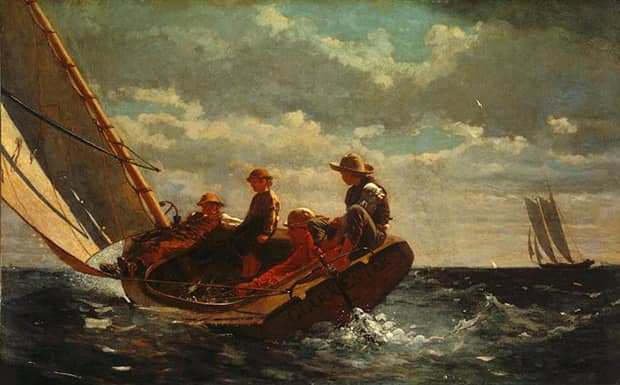
Realism in art involves depicting subjects and situations as they are. It constitutes creating images without any artificial, supernatural, or speculative elements in an attempt to convey the scene, scenario, or emotions naturally.
The realist movement was most popular in France, peaked in the late 19th century, and undoubtedly influenced the artworks of one of America’s most famous and revered artists, Winslow Homer.
Winslow Homer’s artworks mainly featured American landscapes, seaside views, and laborers in the most natural and true-to-life depictions.
Keep on reading as we share the artworks through which Winslow Homer spearheaded the realist movement in America.
Winslow Homer Realist Artworks
Many realist artworks are in the list of Winslow Homer prints depicting 19th-century America. However, the most captivating of these majorly comes from the post-civil war era, when slavery was still a fresh memory or reality.
These Winslow Homer prints give us a glimpse of the odd atmosphere during these times. They show the sad reality of black Africans being put into unfair servitude.
It’s important to note that Winslow Homer worked for Harper’s Weekly, an American political magazine.
This could have rendered his incorporation of realism as a little out of necessity to pass the most truthful narrative. Nonetheless, his execution was impeccable, with some of the most popular of prints.
Sunday Morning in Virginia
The Winslow Homer artwork, “Sunday Morning in Virginia”, is an excellent portrayal of 19th-century American realism during the reconstruction period.
The reconstruction period came after congress ruled on the abolishment of slavery, and with this artwork, we see a paradox.
Rather than an atmosphere of jubilation, the artwork shows us the dejected state of black Americans. This dejected state is particularly encapsulated by the old woman singled out by her bright red scarf and gazing toward space in the slave cabin.
The old woman represents the reality of long-time slaves at that time who have had their lives wasted in servitude.
Freedom cannot make up for the suffering they experienced, and they don’t know how to live any other life; hence, they look forward to nothing.
The children live in another reality as they have something to look forward to. The children are seen relinquishing their thirst for learning by reading a book.
This is an exercise they weren’t allowed to engage in before the abolishment of slavery, and Winslow Homer uses his artwork to address this issue around literacy.
From the old woman to the children, we see defeat from the past and hope for the future for a race living in complex realities. Winslow Homer perfectly captures these complexities through “Sunday Morning in Virginia”.
The Cotton Pickers
Easily deduced from its name, Winslow Homer’s “The Cotton Pickers” is another portrayal of the paradox of realities present in America during the Reconstruction period.
Even when slavery was abolished, the artwork shows that nothing had changed for some black Americans. However, as in “Sunday Morning in Virginia”, we see something deeper.
The faces of the “cotton pickers” is devoid of any form of happiness from the abolishment. Is this countenance due to pain from the past?
Has this countenance and the decision to remain in servitude come from uncertainty or fear about the future? Maybe these come from a combination of both.
Through realistic depictions, “The Cotton Pickers” shows just what the theme of the 19th century was for black Americans; the struggle for freedom and, for some, confusion about what to do with this freedom.
In The Mountains
“In The Mountains” shows another side of the period of Reconstruction. It depicts black women stretching their newfound freedom as they go for a mountain hike, an activity that wasn’t common with women then.
Through true-to-life colors to depict the lighting, women, terrain, and sky, Winslow Homer shows us the early involvement of black American women in the women’s rights movement.
Through realism, the unaccompanied women exercise social independence, and this Winslow Homer print shows the apparent changing reality for black American women.
The Life Line
Winslow Homer’s “The Life Line” takes us away from the theme of slavery to that of innovation and danger. The title “The Life Line” describes the Breeches Buoy, an innovation in lifesaving at that time used to transfer passengers from a ship to safety.
In this artwork, the Life Line gives another lifeline, with a seemingly unconscious woman taken to safety by a savior.
This savior is kept anonymous, though, and we can say this is an attempt by Winslow Homer to keep praises of heroism for the innovative lifesaving technology alone.
Winslow Homer also takes us closer to the rescue. Through elements of realism, we have an idea of how dangerous the mission is within the wild waves of the sea.
The rescuer and passenger both have their feet dipped in the ocean, the waves violently crash against themselves, and the day is dark, signaling the presence of a storm or laying out the dark insecurity of the night.
Rocky shore, Bermuda
Comparatively more straightforward in interpretation, Rocky Shore is one of the few Winslow Homer watercolor paintings infused with a touch of realism.
It depicts a section of a calm sea passing between two heaps of rock, with the day brightened by the sun and a couple of human images seen on the shores. This Winslow Homer painting depicts a sense of calm and serenity.
Conclusion
There’s much to learn about Winslow Homer and his depictions of realism through art. Winslow Homer’s prints often go beyond just using realistic colors and tones.
They pass their messages without being superficial, helping to record American history as it was and always giving one of the most true-to-life depictions of 19th-century sceneries.


